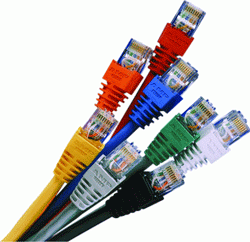For businesses, leased telecom lines have been the long-time standard for direct connections between locations or for dedicated internet access. Let’s explore the available leased line options and the significant price changes in recent years.
First, let’s define what a leased line is and how it compares to other bandwidth solutions. The name “leased line” is fairly self-explanatory. You enter into a contract, usually for 1 to 3 years, with a telecom carrier for exclusive use of a dedicated line. Your data is the only traffic on this line, allowing you to utilize it fully or let it sit idle without affecting the cost. Pricing is calculated based on a fixed Mbps rate per month.
It is important to note that this refers to Megabits per second, not the total amount of data transferred each month. This bandwidth determines the maximum transmission speed and the highest number of bits the line can handle within a month. In reality, very few dedicated lines reach maximum capacity. Users typically maintain a reserve to manage fluctuations between peak and average usage. In practical terms, the lines experience periods of both high and low load.
Dedicated telecom lines are highly dependable, with guaranteed uptime often expressed as 99.9% or 99.99%. The ultimate goal is 99.999% availability, also known as “five nines.” When you sign up for a leased line, it usually includes a Service Level Agreement (SLA) that outlines the guaranteed uptime, average repair time in case of outages, and compensation if the provider fails to meet the SLA terms.
Leased lines are a professional-grade service primarily used by businesses and organizations, not individual consumers. Many carriers won’t even install a leased line to a residential address. This is rarely an issue because leased lines are significantly more expensive than residential broadband.
Why are consumer line services like cable and DSL so much more affordable? One reason is shared bandwidth. You and many of your neighbors share a leased line installed by the service provider at their facility. You receive the full bandwidth if you’re the only one using the line. However, this is not the leased line’s full speed but a lower maximum rate based on your monthly payment. If several neighbors are simultaneously streaming video, everyone’s line speed slows down significantly. Most businesses require the consistent bandwidth of leased lines and cannot tolerate such unpredictable performance.
Unlike leased lines, consumer line services lack a formal SLA and are offered on a “best effort” basis. This means you get what you get, and issue resolution times are unpredictable. The absence of guaranteed service levels contributes to the lower prices of residential bandwidth. Additionally, direct point-to-point connectivity is not an option for consumers. All residential services connect through the internet. To establish a secure point-to-point connection, you would need to set up a Virtual Private Network (VPN) between the desired locations.
T1 lines have been a longstanding and popular choice for leased lines. A point-to-point T1 connects two locations directly, while a dedicated internet access T1 connects you to the internet. You can even get a T1 telephone trunk that provides up to 24 outside lines for your business phone system.
The cost of T1 lines has dropped significantly, from over a thousand dollars to under $300 per month in many areas. For this price, you get exclusive access to 1.5 Mbps for the duration of your contract. If you require higher bandwidth, you can combine, or “bond,” multiple T1 lines to achieve speeds of 3, 4.5, 6, 7.5, 9, 10.5, or 12 Mbps.
What are the alternatives to T1? A newer service called Ethernet over Copper (EoC) is a wired service that provides high bandwidth at lower costs, but with some distance limitations. The entry-level EoC service typically offers 3 Mbps for the same price as a 1.5 Mbps T1 line. Bandwidth can readily scale up to 10 or 20 Mbps, with some areas offering up to 45 Mbps or even 100 Mbps. The cost per Mbps decreases as you increase the bandwidth.
For those needing bandwidth beyond what copper can provide, fiber optic leased lines are the next step. DS3, at 45 Mbps, is often delivered via a combination of fiber optic lines to your building and copper coaxial lines to your equipment. SONET, a fully fiber optic service, starts at 155 Mbps and can reach speeds of 1 to 10 Gbps in most locations, with some areas offering up to 40 Gbps or even 100 Gbps.
Ethernet over Fiber (EoF), similar to EoC, provides scalable bandwidth options ranging from 10 Mbps to 10 Gbps at a significant cost saving compared to traditional SONET fiber services. Unlike copper-based Ethernet, fiber optic Carrier Ethernet has no distance limitations.
These are the main dedicated line services businesses can choose from. However, Ethernet Line service over MPLS networks might be more cost-effective for international connections or connecting multiple locations. While MPLS is not a dedicated line service, virtual dedicated connections can be established to ensure consistent performance across the MPLS network.
If your business needs a direct connection between two sites or to the internet, several providers likely offer both copper and fiber solutions in your area. Check leased line prices and options to see what is available now.
Note: Photo of Ethernet cables courtesy of Wikimedia Commons.


